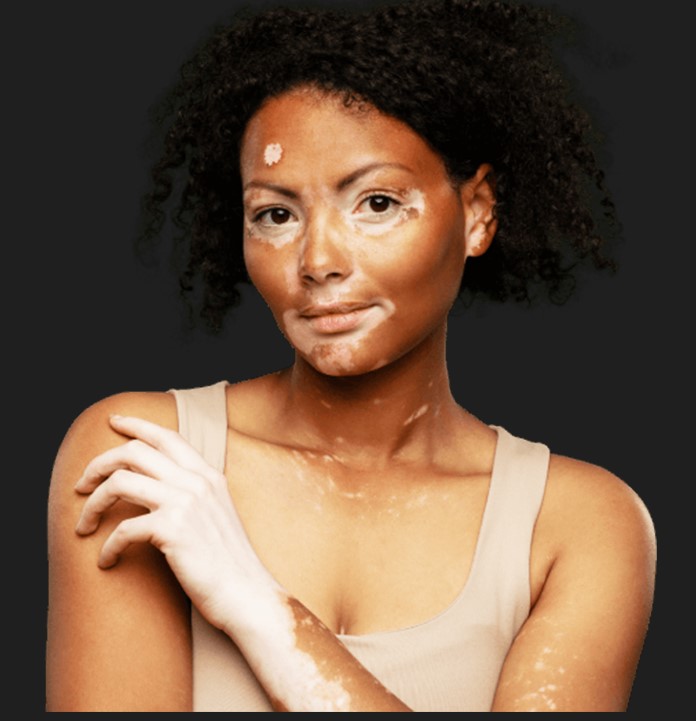What Is Vitiligo?
Vitiligo is a long-lasting condition that causes a loss of color in patches on the skin. It happens when the body’s immune system mistakenly attacks and destroys the skin cells that make color or pigment (melanocytes), turning the affected skin milky white.
Any location on the body can be affected, and most people with vitiligo have white patches on many areas. These patches can show up on the same area on both sides of the body, such as on your hands or knees. They can also appear suddenly, covering a large area of your skin.
Vitiligo vs. Albinism
Albinism is a skin condition that runs in the family. It happens you have inherited mutated genes that cause abnormal melanocytes that can’t properly make or distribute melanin throughout the skin, causing your skin, hair, and eyes to look pale.
In vitiligo, on the other hand, melanocytes are destroyed and the affected areas of the skin appear in milky-white patches.
Also, albinism appears at birth, whereas vitiligo usually develops over time and typically appears before age 40.
Studies are ongoing about whether vitiligo can be passed down; they indicate that 30% of vitiligo cases are genetic.
Vitiligo Causes
When the body’s immune system attacks and destroys its melanocytes, which make melanin. The loss of melanin causes the skin to lose its characteristic color.
It is unclear what triggers the immune system to attack melanocytes in the skin. Research suggests sunburn, emotional distress, exposure to a chemical pollutant, or other stressful events can trigger or worsen vitiligo.
Although vitiligo affects all races equally, it’s more noticeable in dark-skinned people.
Is vitiligo genetic?
More research is needed to understand what causes vitiligo, but studies show that 30% of cases are genetic.
Vitiligo Causes
When the body’s immune system attacks and destroys its melanocytes, which make melanin. The loss of melanin causes the skin to lose its characteristic color.
It is unclear what triggers the immune system to attack melanocytes in the skin. Research suggests sunburn, emotional distress, exposure to a chemical pollutant, or other stressful events can trigger or worsen vitiligo.
Although vitiligo affects all races equally, it’s more noticeable in dark-skinned people.
Is vitiligo genetic?
More research is needed to understand what causes vitiligo, but studies show that 30% of cases are genetic.
Vitiligo is related to gene changes involved in immune system function or melanocytes. Researchers have identified over 30 genes having variations that make you more likely to have vitiligo. NLRP1 and PTPN22 are two of these genes.
Vitiligo may be due to both genetics and environmental factors. However, many of these factors are unknown.
Vitiligo Risk Factors
It usually develops early in life, between ages 10 and 30. It will almost always show up before age 40.
Vitiligo may run in families. You’re more likely to get it when someone in your family has it, too, or when your family gets gray hair prematurely.
Vitiligo Symptoms
You’ll often lose pigment quickly on several areas of your skin. After the white patches appear, they may stay the same for a while but get bigger later. You may have cycles of pigment loss and stability.
Vitiligo commonly affects:
- Body folds (such as armpits)
- Places that have been injured in the past
- Areas exposed to the sun
- Around moles
- Around body openings
- Mucous membranes (tissues that line your nose and mouth)
- Eyelids
- Hair
It’s rare for pigment to return once the white patches have developed.
Vitiligo Types
There are five types of vitiligo. The type you have depends on where it’s located.
- Generalized vitiligo is the most common type, in which discolored patches show up all over your body.
- Segmental vitiligo is when your vitiligo happens only in one area of your body, such as your face or hands.
- Focal vitiligo happens when the discoloration stays in one spot and doesn’t spread.
- Trichrome vitiligo is when there is an area of heavy discoloration, followed by an area of lighter discoloration, and then regular-color skin.
- Universal vitiligo is a rare type. If you have this, at least 80% of your skin will lose its color.
Source: webmd.com









